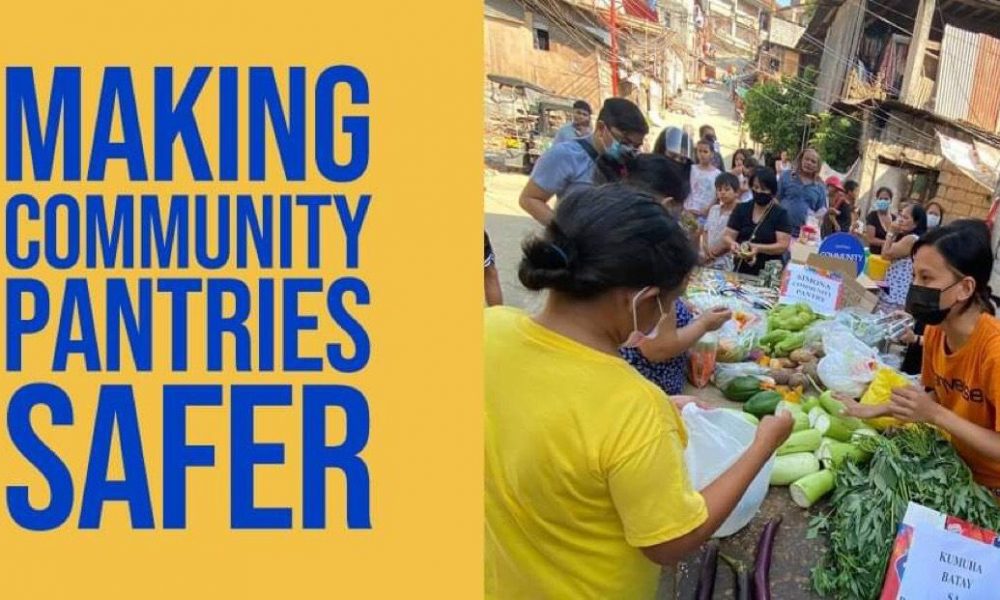Home > Blog > Covid-19
Making Community Pantries Safer

Sometimes, it only takes a small step to spark a movement.
When 26-year-old Ana Patricia “Patreng” Non decided to start a community pantry near her home in Maginhawa Street, Quezon City, it was because she wanted to help. “My small business was affected because of the lockdown,” she explained in Filipino in a Panahon TV interview. “But even if I didn’t have any income, I could still eat three times a day. I thought of those whose livelihoods depended on being out on the streets. They needed support.”
Soon, news about Patreng’s Maginhawa Community Pantry, fashioned from a bamboo cart, spread like wildfire. People came in droves, dropping off food donations, and getting food. The initiative was so popular that even the German Ambassador to the Philippines Anke Reiffenstuel dropped by to donate goods. She tweeted that she was “deeply impressed by the solidary spirit of the Filipinos.”
 Patreng and her bamboo cart of donated goods (photo from AP Non)
Patreng and her bamboo cart of donated goods (photo from AP Non)
Maginhawa Community Pantry’s Evolution
To accommodate the growing volume of crowd and donations, the pantry relocated to a bigger space at the Teacher’s Village East Barangay Hall. Quezon City authorities were called in to maintain health protocols. But the line continued to grow, extending all the way to Philcoa along Commonwealth Avenue. Senior citizens, though prohibited to go out of their homes, joined the queue. To get in line early, people broke curfew.
To address these challenges and to meet the needs of community pantries that mushroomed in the area and all over the country (as far as Mindanao), the Maginhawa Community Pantry recently announced that it would no longer serve beneficiaries. Instead, the pantry has evolved into a drop-off point for donations, which will be distributed among other pantries and places that needed aid. This decentralizing move seeks to promote better barangay coordination and observation of health protocols, and to spread out the crowd lining up for goods.
 Inspired by Patreng’s initiative, UP Campus residents set up their own community pantry. (photo by Mary Jhoy Aap)
Inspired by Patreng’s initiative, UP Campus residents set up their own community pantry. (photo by Mary Jhoy Aap)
Ensuring Safety in Community Pantries
Though initiating community pantries is commendable, organizers should always remember that the country is still grappling with the pandemic. Safety and Preparedness Advocate Martin Aguda Jr. explained in Filipino, “Each time you go out—whether you’re an organizer, a volunteer, a donor or a beneficiary—you are at risk for COVID-19, especially in crowded community pantries.”
On the day when a senior citizen collapsed and died while waiting in line at a community pantry, the Quezon City government released its Community Pantry Guidelines to minimize health risks. Aguda also offers these tips:
Map out a risk management plan. Recognize the risks of your endeavor. How will these affect everyone involved? “You have to check the risks and you have to put in your safety measures,” stressed Aguda. The risk management plan involves wisely choosing the pantry’s location, which will largely depend on the crowd volume you are capable of handling. “Is this an area that will draw in crowds? You need to survey the place because from there, you can gauge your expected crowd.”
Check if your resources are enough. Make sure that the amount of goods you will be distributing matches the expected number of beneficiaries. “When the people outnumber the goods, that will result in long lines and extended waiting time. The longer people wait in line, the more they are exposed to other people and the risk of COVID,” shared Aguda. Limited resources may also cause people to forego discipline and cause a stampede.
Ensure the safety of everyone involved. Aside from making sure everyone is wearing a mask and a face shield, and is practicing physical distancing, organizers should also check the pantry’s surroundings. Aguda explains, “The location should be away from traffic to prevent accidents. Physical distancing can be enforced through physical markers. Enlist the help of safety officers or barangay officials to ensure that lines and health protocols are followed.” Aguda also suggested to set early operation hours so people don’t have to wait under the heat of the sun. This reduces the risk of heat stroke and dehydration.
Regularly brief the crowd. Reminding the crowd to follow health protocols cannot be made often enough. Because there’s always a fresh batch of people joining the line, always reiterate the measures to ensure their safety. Set an example by wearing PPEs and following physical distancing. Provide alcohol for public use.
“It all boils down to planning. We all want to help, but we don’t want to deal with unintended consequences,” warned Aguda. He advised people going to community pantries to also bring drinking water and umbrellas. “Learn to be practical. Remember your health is at risk.”
In turn, Aguda advised organizers to never let their guards down. “You need to protect yourself because you are interacting with different people. Don’t remove your mask at any time. Your volunteerism is a noble act, but you can still help others by ensuring your own safety,” he ended.
Watch Panahon TV’s full interview with Martin Aguda Jr. here.
For those who want to donate to the Maginhawa Community Pantry, visit its Facebook page.

